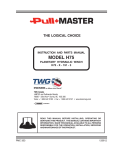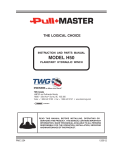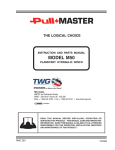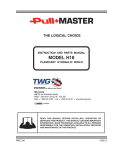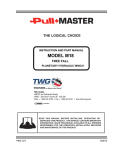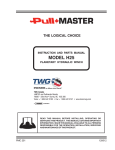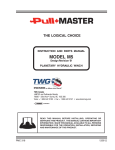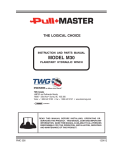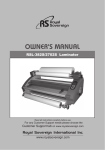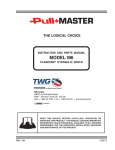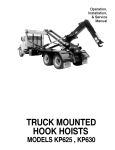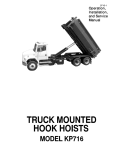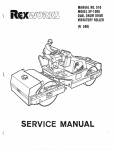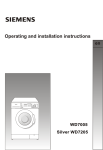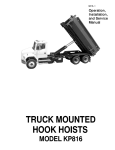Download Model M75 Service Manual
Transcript
INSTRUCTION AND PARTS MANUAL MODEL M75 PLANETARY HYDRAULIC WINCH THE LOGICAL CHOICE PULLMASTER WINCH CORPORATION 8247-130th Street, Surrey, B.C. V3W 7X4, Canada Telephone: 604-594-4444 Fax: 604-591-7332 Website: www.pullmaster.com E-mail: [email protected] READ THIS MANUAL BEFORE INSTALLING, OPERATING OR SERVICING THIS PRODUCT. THIS MANUAL CONTAINS IMPORTANT INFORMATION. MAKE THIS MANUAL AVAILABLE TO ALL PERSONS RESPONSIBLE FOR THE OPERATION, INSTALLATION, SERVICING AND MAINTENANCE OF THIS PRODUCT. PMC 354 070228 Pullmaster Limited Warranty Effective 8/1/2008 SUPERSEDES ALL PRIOR WARRANTIES Seller warrants that each article (whether Gear Drive Products, Brake Products and/or Winch Products, all of which are covered hereunder) sold under this order shall at the time of shipment (i) conform to applicable specifications, and (ii) be free from defects in material and workmanship during normal and ordinary use and service (the "Warranty"). Buyer's exclusive remedy and Seller's sole obligation under this Warranty shall be, at Seller's option, to repair or replace any article or part thereof which has proven to be defective, or to refund the purchase price of such article or part thereof. Buyer acknowledges that Buyer is knowledgeable concerning the articles covered by this Warranty and sold in connection therewith which are being purchased, that Buyer has reviewed this Warranty and that the remedies provided hereunder are adequate and acceptable to Buyer. This Warranty shall expire one (1) year from the date the article is first shipped by Seller. Notice of claimed breach of this Warranty must be given by Buyer to Seller within the applicable period. Such notice shall include an explanation of the claimed warranty defect and proof of date of purchase of the article or part thereof for which warranty coverage is sought. No allowances shall be made by Seller for any transportation, labor charges, parts, "in and out" costs, adjustments or repairs, or any other work, unless such items are authorized in writing and in advance by Seller. Nor shall Seller have any obligation to repair or replace items which by their nature are expendable. If an article is claimed to be defective in material or workmanship, or not to conform to the applicable specifications, Seller will either examine the article at Buyer's site or issue shipping instructions for return to Seller. This Warranty shall not extend to any articles or parts thereof which have been installed, used, or serviced otherwise than in conformity with Seller's applicable specifications, manuals, bulletins, or instructions, or which shall have been subjected to improper installation, operation, or usage, misapplication, neglect, incorrect installation, overloading, or employment for other than normal and ordinary use and service. This Warranty shall not apply to any article which has been repaired, altered or disassembled, or assembled by personnel other than those of Seller. This Warranty shall not apply to any article upon which repairs or alterations have been made (unless authorized in writing and in advance by Seller). This Warranty shall not apply to any articles or parts thereof furnished by Seller to Buyer's specifications and/or furnished by Buyer or acquired from others at Buyer's request. SELLER MAKES NO EXPRESS WARRANTIES AND NO IMPLIED WARRANTIES OF ANY KIND, OTHER THAN THE WARRANTY EXPRESSLY SET FORTH ABOVE. SUCH WARRANTY IS EXCLUSIVE AND IS MADE AND ACCEPTED IN LIEU OF ANY AND ALL OTHER WARRANTIES, EXPRESS OR IMPLIED, INCLUDING WITHOUT LIMITATION THE IMPLIED WARRANTIES OF MERCHANTABILITY AND FITNESS FOR A PARTICULAR PURPOSE. Buyer expressly agrees that Seller is not responsible to perform any work or investigation related in any way to tensional vibration issues and is not responsible for the detection or remedy of Natural Frequency Vibration of the mechanical system in which the unit is installed. Buyer acknowledges, understands and agrees that this Warranty does not cover failures of the unit which result in any manner from the operation of the machine or unit at vibration frequencies at or near the natural frequency vibration of the machine in such a way that damage may result. Buyer expressly agrees that Seller is not responsible for failure damage or accelerated wear caused by machine or ambient vibration. Further, Buyer acknowledges and agrees that Buyer is always solely responsible for determination and final approval of the “ application factor” which may be used in Seller’ s calculations, and this application factor is 1.0 unless otherwise stated in Seller’ s quotation specifications. The remedies for this Warranty shall be only those expressly set forth above, to the exclusion of any and all other remedies of whatsoever kind. The limited remedies set forth above shall be deemed exclusive, even though they may fail their essential purpose. No agreement varying or extending the foregoing Warranty, remedies, exclusions, or limitations shall be effective unless in a writing signed by an executive officer of Seller and Buyer. This Warranty is non-transferable. If a party who had purchased articles from Buyer, or from persons in privity with Buyer, brings any action or proceeding against Seller for remedies other than those set forth in this Warranty, Buyer agrees to defend Seller against the claims asserted in such action or proceeding at Buyer’ s expense, including the payment of attorneys’ fees and costs, and indemnify Seller and hold Seller harmless of, from and against all such claims, actions, proceedings or judgments therein. Buyer also agrees to defend and indemnify Seller of, from and against any loss, cost, damage, claim, debt or expenses, including attorneys’ fees, resulting from any claims by Buyer or third parties to property or injury to persons resulting from faulty installation, repair or modification of the article and misuse or negligent operation or use of the article, whether or not such damage to property or injury to persons may be caused by defective material, workmanship, or construction. ADVISORY: Winches and hoists are not approved for lifting or handling personnel or persons unless specifically approved in writing from Seller for the specific intended application. Under no circumstances shall Seller be liable (i) for any damage or loss to any property other than the warranted article or part thereof, or (ii) for any special, indirect, incidental, or consequential damage or loss, even though such expenses, damages, or losses may be foreseeable. The foregoing limitations on Seller's liability in the event of breach of warranty shall also be the absolute limit of Seller's liability in the event of Seller's negligence in manufacture, installation, or otherwise, with regard to the articles covered by this Warranty, and at the expiration of the Warranty period as above stated, all such liabilities shall terminate. Buyer’ s purchase of any article(s) covered by this Warranty shall constitute acceptance of the terms and conditions hereof and shall be binding upon Buyer and Buyer’ s representatives, heirs and assigns. The laws of the Province of British Columbia shall govern Buyer’ s rights and responsibilities in regard to this Warranty and the transaction(s) subject thereto, and the Province of British Columbia shall be the exclusive forum and jurisdiction for any action or proceedings brought by Buyer in connection herewith or any dispute hereunder. If any of the terms and conditions contained within this Warranty are void, the remaining provisions thereof are and shall remain valid and enforceable. Note: Prices and specifications contained in this price book are subject to change without notice. US.DIST.01.01.07 [PULLMASTER LOGO] TABLE OF CONTENTS SAFETY RECOMMENDATIONS ................................................................ 1 DECRIPTION OF THE MODEL M75 .......................................................... 2 EXPLANATION OF THE MODEL CODING ............................................... 3 OPTIONS ..................................................................................................... 4 SPECIFICATIONS ....................................................................................... 5 PERFORMANCE GRAPHS ..................................................................... 6-7 TYPICAL HYDRAULIC CIRCUIT ............................................................... 8 RECOMMENDATIONS ............................................................................... 9 INSTALATION INSTRUCTIONS ......................................................... 10-11 OPERATING INSTRUCTIONS ................................................................. 12 TROUBLE SHOOTING ........................................................................ 13-14 SERVICE INSTRUCTIONS .................................................................. 15-26 RECOMMENDED MAINTENANCE ......................................................... 27 PARTS REFERENCE # / PART # ....................................................... 28-29 ASSEMBLY DRAWING AND EXPLODED VIEW ............................... 30-31 INSTALLATION DRAWING ...................................................................... 32 APPENDIX A (DRUM CODES) ................................................................ 33 APPENDIX B (BRAKE CODES) .............................................................. 34 BOLT TORQUE CHART ........................................................................... 35 354 REV.030819 SAFETY RECOMMENDATIONS Definition: Caution indicates a potentially hazardous situation which, if not avoided may result in minor or moderate injury. DANGER FAILURE TO COMPLY WITH THE FOLLOWING SAFETY RECOMMENDATIONS AND LOCAL RULES AND REGULATIONS WILL RESULT IN PROPERTY DAMAGE, SEVERE INJURY OR DEATH. Definition: Warning indicates a potentially hazardous situation which, if not avoided could result in death or serious injury. Definition: Danger indicates a potentially hazardous situation which, if not avoided will result in death or serious injury. The planetary hydraulic winches are made for hoisting and lowering loads and to be operated by trained and professional personnel. They are not designed for operations involving lifting or moving personnel. The winches are powered by hydraulic power. The ropes / cables for hoisting operations are not supplied by PULLMASTER. The winches are always assembled in an application, they do not function as an independent machine and it is not allowed to use them as such. The winches are to be used within the specifications as listed in the manual under “SPECIFICATIONS”. Other use as foreseen in the functional description of the hydraulic winch is not allowed without written permission from PULLMASTER. 1. Do not install, operate or service winch before reading and understanding manufacturer's instructions. 19. Keep hydraulic system clean and free from contamination at all times. 2. The winch described herein is not designed for operations involving lifting or moving personnel. 20. Maintain winch and equipment in good operating condition. Perform scheduled maintenance regularly. 3. 21. Keep hands clear when winding wire rope onto the winch drum. Do not lift or carry loads over people. 4. Do not exceed recommended operating pressure (psi) and operating volume (gpm). 5. Do not jerk the winch. Always smoothly accelerate and decelerate load. 6. Do not operate a damaged, noisy or malfunctioning winch. 7. Do not leave a load suspended for any extended period of time. 8. Never leave a suspended load unattended. 9. Winch should be maintained and operated by qualified personnel. 10. Inspect winch, rigging, mounting bolts and hoses before each shift. 11. Warm-up equipment before operating winch, particularly at low ambient temperatures. 12. Verify winch function by raising and lowering a full test load to a safe height before each shift. 13. Do not weld any part of the winch. 14. Verify gear lubrication and brake circulation supply and return before operating winch. 15. Be sure of equipment stability before operating winch. 16. Wear proper clothing to avoid entanglement in rotating machinery. 22. Do not use the wire rope as a ground for welding. 23. Rig the winch carefully. Ensure that the wire rope is properly anchored to the correct cable anchor slot at the cable drum. 24. Do not lift a load with a twisted, kinked or damaged wire rope. 25. Consult wire rope manufacturer for size, type and maintenance of wire rope. 26. Maintain five wraps of wire rope under tension on the cable drum at all times. 27. In case of a power failure or breakdown leading to an unexpected stop of the hydraulic power circuit, stand clear of the area and the load being hoisted, take the necessary precautions to prevent access to area where the load is halted. 28. Clean up any oil spillage immediately. 29. Winches should be stored in inside facility. 30. Do not store beyond a period of one year without operation because of limited shelf life of “o” rings and oil seals. 31. Wear proper clothing and personal protection equipment such as, footwear, safety goggles and a hard hat. Read manual first. 17. Always stand clear of the load. 18. Use only recommended hydraulic oil and gear lubricant. 354 REV.051117 PAGE 1 DESCRIPTION OF THE MODEL M75 GENERAL DESCRIPTION: The PULLMASTER Model M75 is a planetary hydraulic winch with reversing speeds 4.1 times faster than forward speed. The main components of this unit are: ✛ ✛ ✛ ✛ ✛ ✛ ✛ ✛ hydraulic gear motor multi disc brake with static and dynamic function primary planet reduction secondary planet reduction final planet reduction brake housing final drive housing cable drum FUNCTION IN FORWARD ROTATION (HOISTING): In forward rotation, or when the winch is pressurized for hoisting, the output torque and rpm of the hydraulic motor are transmitted to the sungear of the primary planet reduction. The output torque and rpm of the primary reduction stage are transmitted to the secondary reduction stage by the secondary sungear, which is splined to the primary planet hub. The final sungear is splined to the secondary planet hub and transmits the output torque and rpm of the secondary reduction stage to the final planet reduction stage. The final planet hub is splined onto the cable drum. In forward rotation, or when a load is raised, an over-running clutch, which connects the motor drive shaft to the automatic brake assembly, permits free rotation of the sungear, without effecting the brake. When the winch rotation is stopped, the load on the cable drum causes the over-running clutch to lock and the maximum load is held safely by the disc brake. FUNCTION IN REVERSE ROTATION (LOWERING): In reverse rotation, or when the winch is pressurized for lowering of a load, hydraulic pressure from the reverse side of the hydraulic motor is channelled to the brake piston, causing the brake piston to release the multi-disc brake against a number of brake springs. The pressure required to release the brake is 400-800 psi (28-55 bar). The overrunning clutch, connecting the motor drive shaft to the brake assembly, locks, causing the brake disks to rotate between divider plages, which are engaged into the brake housing. If the load on the cable drum tends to affect the lowering speed, the resulting pressure drop in the brake piston causes friction between the brake discs and the divider plates. In this way a completely smooth lowering speed can be achieved in a stepless operation by modulation of the winch control handle. When the control handle is returned to neutral position, rotation stops and the disc brake applies automatically. During the lowering operation of the winch, the friction created by the brake discs results in heat. This heat is dissipated by the circulation of hydraulic fluid through the brake housing, supplied externally. For efficient cooling of the automatic brake, models with external circulation should be adjusted to supply 7.0 (US) gpm-26 l/min. This circulation flow must be returned directly to the reservoir with a permissible back pressure of 30 psi (2 bar). IMPORTANT: PAGE 2 Under no circumstances must the pressure in the brake housing be permitted to exceed 30 psi (2 bar). Excessive pressure in the brake housing will damage the oil seal separating the brake housing from the drum interior. Damage to this seal will cause the drum to fill up with hydraulic fluid. In order to prevent potential damage to the drum seals and the end cover of the winch, when the cable drum fills up with hydraulic fluid, a breather relief (see PARTS REFERENCE, item 130) is installed on the end cover. The breather relief bleeds to atmosphere and serves as a warning signal that the oil seal between brake housing and drum has been damaged. 354 REV.030819 EXPLANATION OF MODEL CODING M 75 X - XX - XX - XX X - X XXXX BASIC UNIT SERIES M = Equal Speed SIZE OF UNIT REDUCTION RATIO Only used for non standard reduction ratios TYPE OF BRAKE -7 Automatic brake, clockwise drum rotation, external circulation flow -8 Automatic brake, external brake release, clockwise drum rotation, external circulation flow -9 Automatic brake, external brake release, counterclockwise drum rotation, external circulation flow -10 Automatic brake, counterclockwise drum rotation, external circulation flow HYDRAULIC MOTOR -191 Hydraulic motor, 3 inch gear section (12.3 cubic inch displacement) (Other gear sections for this motor are optional) DRUM SIZE -1 16 inch drum diameter X 32 inch flange diameter X 20 inch length -4 14 inch drum diameter X 35 inch flange diameter X 36 inch length OPTIONS DESIGN REVISION SPECIFICATION NUMBER Describes features not identified by preceding codes NOTE: Clockwise and counterclockwise drum rotation is the direction of rotation for pulling or hoisting, established by looking at the hydraulic motor. 354 REV.030819 PAGE 3 OPTIONS COUNTERCLOCKWISE ROTATION: The drum rotation of the standard PULLMASTER Model M75 planetary winch is clockwise for pulling or hoisting when looking at the hydraulic motor of the winch. Drum rotation for counterclockwise pulling or hoisting direction is available as an option. EXTERNAL BRAKE RELEASE: PULLMASTER planetary winches can be supplied with an external brake release which permits release of the automatic disc brake from an external pressure source. DANGER FAILURE TO PROPERLY VENT EXTERNAL BRAKE RELEASE PORT WILL TRAP BRAKE PRESSURE AND ALLOW THE LOAD TO DROP, CAUSING PROPERTY DAMAGE, SEVERE INJURY OR DEATH. WINCHES SUPPLIED WITH EXTERNAL RELEASE OPTION MUST BE CONNECTED ACCORDING TO "TYPICAL HYDRAULIC CIRCUIT". CABLE DRUM SIZES: Aside from the standard drum sizes listed, the PULLMASTER Model M75 planetary winch may be supplied with optional drums to accommodate large wire rope storage capacity. DRUM GROOVING: Cable drums for the PULLMASTER Model M75 planetary winch may be grooved. Where this option is a requirement, it is necessary to state the size of wire rope which is to be used with the winch. OPTIONAL GEAR SECTION FOR THE HYDRAULIC MOTOR: The performance of the standard PULLMASTER Model M75 planetary winch may be changed by using a different displacement motor. (Contact the factory for performance information.) HYDRAULIC MOTORS FOR HIGH PRESSURE HYDRAULIC SYSTEMS: The operating pressure of the PULLMASTER Model M75 planetary winch with -191 motor is limited to 3000 psi (270 bar). For hydraulic systems operating with a higher range of hydraulic pressure, the winch can be supplied with a hydraulic piston motor, which will provide for the same basic performance in terms of line pull and line speed capacity. (Contact the factory for this requirement.) FREESPOOLING: This option permits wire rope being pulled off the cable drum by an operator. Freespooling should not be confused with free fall. The freespool coupling cannot be disengaged or re-engaged with a load on the wire rope or while the cable drum is turning. The PULLMASTER WINCH CORPORATION will consider other options for quantity requirements. PAGE 4 354 REV.030819 SPECIFICATIONS Performance specifications are based on standard -191 hydraulic motor and gear ratio with 1 1/8" inch diameter wire rope. For other cable drums, reductions or motors, refer to supplement inside back cover. Performance specifications for winches supplied with optional motors are provided in attached supplement. DRUM CODES - 1 Drum CABLE DRUM DIMENSIONS Barrel diameter Flange diameter Barrel length - 4 Drum 16.0 in (406 mm) 32.0 in (813 mm) 20.0 in (508 mm) 14.0 in (356 mm) 38.0 in (965 mm) 36.0 in (914 mm) 907 ft (276 m) 727 ft (221 m) 559 ft (170 m) 2489 ft (759 m) 2104 ft (641 m) 1503 ft (458 m) MAXIMUM OPERATING PRESSURE 3000 psi (207 bar) 3000 psi (207 bar) MAXIMUM OPERATING VOLUME 142 (us) gpm (538 l/min) 142 (us) gpm (538 l/min) MINIMUM OPERATING VOLUME 30 (us) gpm (114 l/min) 30 (us) gpm (114 l/min) DRUM TORQUE AT MAXIMUM PRESSURE 642,183 lb - in (72,556 Nm) 642,183 lb - in (72,556 Nm) DRUM RPM AT MAXIMUM VOLUME 16 rpm 16 rpm CABLE STORAGE CAPACITY (size of wire rope) - 1 in - 1 1/8 - 1 1/4 HOISTING LINE FULL AT MAXIMUM PRESSURE - Bare drum - Full drum 75,000 lb (330 kN) 41,748 lb (185.8 kN) 85,000 lb (374 kN) 35,166 lb (154.7 kN) HOISTING LINE SPEED AT MAXIMUM VOLUME - Bare drum - Full drum 72 fpm (21.9 m/min) 129 fpm (39.3 m/min) 64 fpm (19.5 m/min) 154 fpm (47 m/min) PERMISSIBLE SYSTEM BACK PRESSURE AT MOTOR RETURN PORT 65 psi (4.5 bar) 65 psi (4.5 bar) PERMISSIBLE PRESSURE AT CIRULATION SUPPLY PORT 30 psi (2 bar) 30 psi (2 bar) 13 (US) Gallons (49 Liters) 15 (US) Gallons (57 Liters) LUBRICATING OIL VOLUME (Refer to RECOMMENDATIONS for viscosity and instructions 354 REV.040901 PAGE 5 PERFORMANCE GRAPHS PG-M75 MODEL NUMBER: M75-X-191-1 LINE PULL VS. OIL PRESSURE LINE PULL - kN 66 100 133 166 200 233 266 300 333 3000 207 2500 172 DR UM LL 2000 E FU R BA DR 138 1500 103 1000 69 500 34 OIL PRESSURE - bar 33 UM OIL PRESSURE - psi 0 0 0 0 7500 15000 22500 30000 37500 45000 52500 60000 67500 75000 LINE PULL - lb LINE SPEED VS. OIL VOLUME LINE SPEED - m/min 12 18 24 30 36 42 125 473 R U M 568 UM E D 100 R L UL 379 DR F 75 284 50 189 25 95 OIL VOLUME - l/min 6 BA OIL VOLUME - (US)gpm 0 150 0 0 0 20 40 60 80 100 120 140 LINE SPEED - fpm Performance graphs are based on standard hydraulic motor, gear ratio and cable drum with 1 1/8 inch diameter wire rope. PAGE 6 354 REV.030819 PERFORMANCE GRAPHS PG-M75-4 MODEL NUMBER: M75-X-191-4 LINE PULL VS. OIL PRESSURE LINE PULL - kN 66 100 133 166 200 233 266 300 333 366 400 2500 172 DR UM 207 UM E AR LL 2000 138 DR B 1500 103 1000 69 500 34 OIL PRESSURE - bar 33 FU OIL PRESSURE - psi 0 3000 0 0 0 7500 15000 22500 30000 37500 45000 52500 60000 67500 75000 80000 85000 LINE PULL - lb LINE SPEED VS. OIL VOLUME LINE SPEED - m/min 0 6 12 18 24 30 36 42 48 568 R U M UM LL DR FU 379 R E D 100 75 284 50 189 25 95 OIL VOLUME - l/min 473 125 BA OIL VOLUME - (US)gpm 150 0 0 0 20 40 60 80 100 120 140 160 LINE SPEED - fpm Performance graphs are based on standard hydraulic motor, gear ratio and cable drum with 1 1/8 inch diameter wire rope. 354 REV.030819 PAGE 7 TYPICAL HYDRAULIC CIRCUIT HC-H/M75-STD EXTERNAL BRAKE RELEASE 800 PSI (55 BAR) AT 1 L/MIN CIRCULATION SUPPLY LINE H75:9(US)GPM (34 L/MIN) M75:7(US)GPM (26 L/MIN) CIRCULATION RETURN LINE (MUST GO DIRECT TO RESERVOIR) CONTROL VALVE (MOTOR SPOOL) 4-WAY SPRING RETURN TO CENTER PRESSURE RELIEF VALVE FILTER HYDRAULIC PUMP PAGE 8 RESERVOIR 354 REV.030819 RECOMMENDATIONS HYDRAULIC FLUID: HYDRAULIC PRESSURE RELIEF: The hydraulic fluid selected for use with PULLMASTER planetary winches should be a high grade, petroleum based fluid, with rust, oxidation and wear resistance. Fluid cleanliness and operating viscosity are critical to winch reliability, efficiency and service life. The hydraulic circuit for the PULLMASTER planetary winch requires a pressure relief set at the operating pressure (see SPECIFICATIONS). Usually, a pressure relief is part of the hydraulic control valve. Where this is not the case, a separate pressure relief valve must be installed and set at the recommended maximum pressure. For optimum performance, the recommended viscosity range at operating temperature is 81 - 167 SUS (16 - 36 CS). For extreme operating conditions of short duration, the maximum viscosity range of 58 - 4635 SUS (10 1000 CS) should not be exceeded. For optimum performance, the winch recommended hydraulic fluid temperature operating range is 80 - 150F (27 - 66 C). For extreme operating conditions of short duration, the maximum temperature range of -5 - 180F (-21 - 82 C) should not be exceeded. LUBRICATION: The winch gear train requires oil bath lubrication. The winch is shipped from the factory without lubricating oil. IMPORTANT: ADD LUBRICATING OIL BEFORE RUNNING WINCH. Refer to INSTALLATION DRAWING for location of lubricating oil fill port. Refer to SPECIFICATIONS for quantity of oil required. For normal operating temperature use SAE 90 lubricating oil. Consult lubricating oil supplier or factory for temperatures beyond normal operating range. HYDRAULIC PUMP: For maximum performance of the PULLMASTER planetary winch, the hydraulic pump must supply the maximum flow of hydraulic fluid at the hydraulic pressure stated in SPECIFICATIONS. HYDRAULIC CONTROL VALVE: The standard control valve used for operation of the PULLMASTER planetary winch must have a four-way, spring return to neutral feature, which provides for open flow from the pressure ports of the winch to the reservoir in neutral position of the control (motor spool). It is important to point out that good speed control, especially when lowering a load, depends on the "metering" characteristics of the control valve. The better the oil flow is "metered" the better will be the speed control. 354 REV.030819 HYDRAULIC RESERVOIR: It is recommended that the hydraulic reservoir has sufficient capacity to provide good heat dissipation in order to prevent over-heating of the hydraulic fluid. The hydraulic reservoir should be made from clean and scale-free material to prevent contamination of the hydraulic fluid. In order to prevent air from being mixed with the hydraulic fluid, the reservoir should have an over-flow baffle separating the return lines from the suction line and all return lines should enter the reservoir below the fluid level. The reservoir should be mounted close to and above the hydraulic pump in a location which provides for free air circulation around the reservoir. HYDRAULIC HOSES: The following hydraulic hoses are recommended for maximum efficiency of the PULLMASTER Model M75 planetary winch: Pressure lines: Circulation return line: Circulation supply line: Equivalent to SAE 100R12-32 Equivalent to SAE 100R4-20 Equivalent to SAE 100R6-12 It is recommended that a larger size of hydraulic hose is installed where the pressure lines or the circulation lines are excessively long. HYDRAULIC FILTER: Hydraulic filter recommendations for the hydraulic circuit of the PULLMASTER planetary winch, based on a return line filter, are given as follows: Average Atmosphere: Dusty Atmosphere: 10 microns 5 microns In order to prevent accidental stoppage of the return line flow, the oil filter should have a by-pass feature. USE OF AN E STOP: (FOR EUROPEAN MACHINERY DIRECTIVE APPLICATIONS) The use of an E stop (emergency) is mandatory in the controls circuit. The E stop is to be placed in the operator's control panel. The E stop must be designed and placed in line with EN 60204 and EN 418. PAGE 9 INSTALLATION INSTRUCTIONS DANGER FAILURE TO FOLLOW INSTALLATION INSTRUCTIONS WILL RESULT IN PROPERTY DAMAGE, SEVERE INJURY OR DEATH. The initial installation or mounting of a PULLMASTER planetary winch is critically important for proper operation and performance. If the winch is mounted to an uneven surface, the centre line of the unit can be distorted to a point where the winch will not operate in either direction. It is therefore very important that the following instructions are observed when a PULLMASTER planetary winch is installed: 1) Make certain that the mounting platform is sufficiently strong in order to avoid deflection when a load is lifted. 2) Set the winch on the mounting platform and check Gap “A”, “B”, “C” and “D”. SI1094-2 NOTE: FOR ALL DRUMS EXCEPT -1 MEASURE GAPS BETWEEN HOUSINGS AND DRUM FLANGES TIE BAR JACKING SCREW "B" CABLE DRUM BASE PLATE GAP GAP "C" DETAIL FOR -1 DRUM GAP "A" JACKING SCREW "D" GAP "D" GAP "B" JACKING SCREW "C" JACKING SCREW "A" 3) If Gap “A” is within 0.01” to Gap “B” and Gap “C” is within 0.01” to Gap “D”, proceed to step 5. If Gaps are outside this limit, proceed to step 4. Note: Difference between Gaps “A” and “B” and Gaps “C” and “D” may not be equal. PAGE 10 354 REV.030819 INSTALLATION INSTRUCTIONS CONTINUED 4) Gaps can be adjusted as required by adjusting Jacking Screw diagonally opposite to the Gap. Reduce a gap by turning Jacking Screw clockwise or increase a gap by turning Jack Screw counterclockwise. To adjust Gap “A” TURN Jacking Screw “A”. To adjust Gap “B” TURN Jacking Screw “B”. To adjust Gap “C” TURN Jacking Screw “C”. To adjust Gap “D” TURN Jacking Screw “D”. 5) Measure the space underneath the four mounting pads with a feeler gauge and use shim stock of equivalent thickness in the space between the mounting pad and the mounting surface. Install mounting bolts (for bolt size and grade refer to INSTALLATION DRAWING). Tighten mounting bolts per BOLT TORQUE CHART. 6) Fill the winch with lubricating oil up to Oil Level Plug on End Cover or see SPECIFICATIONS for oil volume required. 7) Use recommended circuit components and hydraulic hoses. 8) The Circulation Return line of the winch should be plumbed in such a manner that the brake housing remains full of oil at all times. Connect the return line directly to reservoir. Do not connect to a common return line. 9) Before operating the winch with a load, verify adequate circulation flow through the Circulation Return Line as stated in TYPICAL HYDRAULIC CIRCUIT. Verify that pressure inside the brake housing, measured at the Circulation Supply Port does not exceed the permissible pressure stated in SPECIFICATIONS. 10) Verify that Breather Relief item 130 is in place on End Cover item 120 above oil level. Rotate End Cover if Breather Relief is below oil level. IMPORTANT: Do not replace breather relief with a pipe plug. The breather relief does not prevent oil seal failure but serves as an indicator or warning that the oil seals between brake housing and the cable drum interior have failed and must be replaced immediately. If these oil seals are changed, additional failure of the drum seal and potential damage to the end cover is prevented. 354 REV.030819 PAGE 11 OPERATING INSTRUCTIONS DANGER FAILURE TO FOLLOW OPERATING INSTRUCTIONS WILL RESULT IN PROPERTY DAMAGE, SEVERE INJURY OR DEATH. After the PULLMASTER planetary winch has been installed in accordance with the INSTALLATION INSTRUCTIONS, the wire rope can be fastened to the cable drum. IMPORTANT: The ropes, chains, slings, etc. are not part of the winch and are not covered by this manual. Refer to the manufacturer's handling, inspection and maintenance recommendations to avoid potential accidents. For selection of ropes, etc. please check the following product standards: DIN 15020, prEN 818-1/9, prEN 1492-1/2, prEN 1677-1/3 and other relevant product standards. 1) The cable drum of the PULLMASTER planetary winch has two pockets for wire rope ferrules, one for clockwise and one for counterclockwise hoisting. Standard rotation for hoisting is clockwise when looking at the hydraulic motor of the unit. It is critical to select the ferrule pocket which will permit winding of the wire rope on the drum in the correct direction of rotation. If the wire rope is wound on the cable drum in the wrong direction of rotation, the winch will have no braking capacity. Each winch is shipped from the factory with a warning label on the drum indicating the correct cable anchor (ferrule) pocket and direction of hoisting. WIRE ROPE INSTALLATION Clockwise hoisting winch shown. (Use ferrule pocket on opposite side of drum for counterclockwise hoisting winch.) Attach ferrule to rope per manufacturers instructions and install ferrule into drum pocket. Pull rope tight and install retainer plate item No, 501. Retainer plate is suitable for ferrule lengths from 2 3/4" to 3 3/16". CABLE DRUM FLANGE 502 FERRULE 503 FERRULE POCKET CLOSEST TO MOTOR (FOR CLOCKWISE ROTATION) 501 SI1013-75 2) For safety the cable drum requires 5 wraps of wire rope. 3) The winch operation is controlled by a single control valve lever which has a forward, a reverse and a neutral position. Speed control in either direction is obtained by modulation of the control valve lever. Maximum line speed in either direction is obtained when the control valve lever is moved as far as it can go. The disc brake of the winch will come on automatically when the winch control lever is returned to neutral. 4) Always warm up equipment prior to operating winch, particularly in low ambient temperature. Circulate hydraulic oil through the winch control valve for several minutes to warm the hydraulic system. To prime the winch with warm oil, operate the winch at slow speed, forward and reverse, several times. 5) Prevent corrosion damage to winch interior. If not used regularly, run winch up and down at least once every two weeks. 6) To ensure proper winch installation and function, raise and lower a full test load to a safe height before using winch for regular operation at the start of each shift. If, after a new installation, the winch does not function properly, refer to the TROUBLESHOOTING section of this manual. PAGE 12 354 REV.051117 TROUBLE SHOOTING GENERAL: In most cases, when the hydraulic winch does not perform satisfactorily, the cause of malfunction is found somewhere in the hydraulic circuit. Before the winch is removed from its mounting and disassembled, all of the hydraulic circuit components should be checked for proper function. IMPORTANT: The hydraulic oil volume relates to the line speed or rpm of the winch. Therefore, if the winch does not produce the specified maximum rated line speed or drum rpm, a loss of hydraulic flow somewhere in the hydraulic circuit system can be analysed. If this condition exists, install a flow meter into the hydraulic circuit to check the volume supplied to the pressure port of the hydraulic winch motor when the winch control is completely opened. The flow meter should indicate the maximum operating volume. If this test indicates a loss of hydraulic flow, check the hydraulic pump, the relief valve and the control valve. If the pump is driven by V-belts, check for belt slippage. The hydraulic pressure relates to the line pull or lifting capacity of the winch. If the winch will not lift the specified maximum line pull, install a pressure gauge into the pressure line leading to the hoisting port on the hydraulic winch motor. Stall the winch to prevent rotation of the drum and then open the control valve. Check the hydraulic pressure reading of the installed pressure gauge. If the pressure reads below the specified maximum operating pressure, look for trouble in the hydraulic pump, the relief valve and the control valve. If the pump is driven by V-belts, check for belt slippage. When checking oil pressure and volume in the hydraulic circuit, make certain that the hydraulic reservoir is filled to the top level and the hydraulic pump is running at maximum operating rpm. Only if the hydraulic system has been checked and found to be in order, use the following indications for probable causes of failure in the winch: FAILURE Winch will not produce line pull at maximum pressure as listed in SPECIFICATIONS. PROBABLE CAUSE a) b) c) d) e) Winch will not produce line speed at maximum volume as listed in SPECIFICATIONS. a) b) c) d) Winch will not reverse. a) b) c) d) e) 354 REV.030819 Winch is mounted to an uneven surface. (See INSTALLATION INSTRUCTIONS.) Cable sheaves or block purchase operated with the winch are not turning freely. Damage or wear in the hydraulic motor. Excessive back pressure in the hydraulic system. Relief valve may be set too low. (See SPECIFICATIONS for maximum operating pressure.) Winch is mounted to an uneven surface. (See INSTALLATION INSTRUCTIONS.) Cable sheaves or block purchase operated with the winch are not turning freely. Damage or wear in the hydraulic motor. Excessive back pressure in the hydraulic circuit. Leakage out of the brake piston prevents the brake from being released against the brake springs. This is caused by damaged O-ring seals on the brake piston. The O-ring seals, on the brake release channel between the motor adaptor and the brake housing is damaged. If this failure occurs there will be substantial leakage from between the motor adaptor and brake housing. Insufficient hydraulic pressure. (See SPECIFICATIONS for minimum operating pressure.) Winch is mounted to an uneven surface. (See INSTALLATION INSTRUCTIONS.) Hydraulic pressure is not reaching the brake piston. PAGE 13 TROUBLE SHOOTING FAILURE Brake will not hold. PROBABLE CAUSE a) b) c) d) e) f) g) Brake vibrates when lowering a load. a) b) c) d) e) f) Oil leaks. CONTINUED a) b) c) Brake plates or divider plates have been damaged by contamination in the hydraulic fluid, or lack of circulation flow in the brake housing. Brake piston is seized in the brake housing because of contamination in the hydraulic fluid. Excessive back pressure in the return line causes the brake to be released. Control valve has incorrect spool, which traps hydraulic pressure in the brake piston when the control valve handle is returned to neutral position. For proper function of the automatic brake, both pressure ports of the winch must be open to the reservoir in neutral position of the control valve. Wire rope is fastened to the incorrect cable anchor pocket. Sprag clutch is damaged or surfaces where sprag clutch engages on motor drive shaft or brake hub are worn or indented. Winch supplied with external brake release option is not plumbed per HYDRAULIC CIRCUIT. Failure to vent external brake release port to reservoir may trap pressure and cause winch brake to slip. Pump is too slow. Pump rpm must be maintained at normal operating speed when a load is lowered. Brake is running too hot. This is caused by a complete lack of, or insufficient circulation flow. To check the circulation, observe the flow of oil from the circulation return line of the winch (see TYPICAL HYDRAULIC CIRCUIT) when the winch is reversed. Control valve has poor metering characteristics. Damaged brake plates or divider plates. The over-running clutch, which connects the motor shaft with the brake assembly, is damaged. Air mixed with hydraulic oil (foamy oil). Oil leaks from the hydraulic motor flange and the motor adaptor are caused by damaged O-ring seals. Oil leaks occurring between the cable drum flanges and housings are caused by excessive pressure in the brake housing. Excessive pressure will damage the oil seal which separates the secondary housing from the cable drum interior. If the breather relief on the end cover leaks, the seal between the drum interior and the secondary housing is damaged and must be replaced. This condition is caused by excessive pressure in the brake housing of the winch, operation with the incorrect hydraulic fluid during cold weather, or a restriction in the circulation return line leading back to tank. Refer to the SERVICE INSTRUCTIONS if it becomes necessary to disassemble the Model M75 winch. PAGE 14 354 REV.030819 SERVICE INSTRUCTIONS GENERAL: Before attempting disassembly of the PULLMASTER model M75 planetary winch, the following instructions for disassembly and reassembly should be read and understood: It is suggested that all expendable parts, such as O-rings and oil seals, are not reused on reassembly. It is therefore important to have a seal kit (Part No. 23839) on hand before the unit is taken apart. NOTE: Oil seal must be installed with backup washer, if included with the seal kit (absence of backup washer in a seal kit indicates, no back up washer required for oil seals). A clean working area is of prime importance, similar to conditions used for service work on any other hydraulic component. All parts, as they are removed from the winch assembly, should be inspected for wear and damage. Worn or damaged parts must be replaced. Thoroughly clean parts before reassembly. Do not use solvent to clean the brake friction plates. During reassembly, lubricate all O-rings and oil seals with grease before installation. In the following service instructions, reference to parts is made by numbers and shown on the applicable drawing and or on the assembly drawing. DISASSEMBLY For the majority of required service or repair work, disassembly may be required only on the brake housing of the PULLMASTER Model M75 planetary winch. Since the parts are heavy, appropriate care should be taken during disassembly and reassembly. Puller holes are provided on the parts, for safety, use of proper eye-bolts or any other safe means must be used for handling parts during assembly and disassembly of the winch. DRAIN OIL FROM THE WINCH: To drain hydraulic oil from the Brake Housing item 700 remove Pipe Plug item 801. To drain gear lube oil from the Primary Housing item 701 and Secondary Housing item 456 remove Pipe Plugs item 121 and 457. To drain gear lube oil from the Final Housing item 100 and Cable Drum item 500 remove Pipe Plug item 121 from End Cover item 120 and Cable Drum item 500. Proceed with the disassembly after draining the oil from the winch as described below: 354 REV.030819 PAGE 15 SERVICE INSTRUCTIONS CONTINUED 1) REMOVAL OF HYDRAULIC MOTOR: (Refer to Parts Reference, APPENDIX B for item numbers) 1.1) Disconnect Brake Hose item 852 from Motor item 850. 1.2) Remove 4 Capscrews item 127 along with Lockwashers item 541 and carefully remove motor from Motor Adaptor item 800. (Motor Drive Shaft item 730 may stay on motor shaft). 1.3) Discard O-Ring, item 819. * * These parts and description vary according to brake code. Refer to APPENDIX B. * Install these parts as shown for clockwise hoisting. Install on opposite motor port for counter-clockwise hoisting. 955 127 541 819 * * ** 858 852 853 858 850 859 854 * * 955 ** ** ** 861 862 860 ** 537 * HYDRAULIC MOTOR 2) REMOVAL OF BRAKE, PRIMARY AND SECONDARY DRIVE SUB-ASSEMBLIES: (Refer to Assembly drawing for item numbers.) 2.1) Remove 12 Capscrews item 537 along with 12 Lockwashers item 541 connecting Secondary Housing item 456 and Primary Housing item 701. Pull Brake Group (brake, primary drive and secondary drive) from Secondary Housing item 456. Secondary Sun Gear item 490 may or may not stay with secondary drive. 2.2) Remove Secondary Sun Gear item 490 Circlip item 491 and Planet Hub-Stopper item 451. PAGE 16 354 REV.030819 SERVICE INSTRUCTIONS CONTINUED 3) DISASSEMBLY OF BRAKE HOUSING AND PRIMARY HOUSING: 3.1) Remove 12 Capscrews item 537 and Lockwashers item 541, from Brake Housing item 700, from Primary Housing item 701. Brake Springs item 752, apply pressure against the Primary Housing item701. It is recommended that Capscrews are unscrewed, one turn at a time, until spring pressure has been released. 3.2) Remove Primary Housing item 701, along with Connecting Shaft item 600, Primary Drive item 399, and Internal Gear item 430 from Brake Housing item 700. 3.3) Remove 20 Brake Springs item 752. Replace if springs measures less than 2.21 inches. 3.4) Pull Brake Piston item 750, out of the Brake Housing using two 5/8-11UNC bolts screwed into two puller holes in piston and discard O-rings item 751 and item 753. 3.5) Remove 6 Friction Plates item 715, and 7 Divider Plates item 713. Inspect for damage or wear. Plates should be flat and smooth. Plates should not show heat discoloration. Paper material on friction plates should be intact and grooved. If any damage is detected, replace friction and divider plates as a set. DANGER DAMAGED FRICTION OR DIVIDER PLATES WILL REDUCE BRAKING CAPACITY AND ALLOW THE LOAD TO DROP, CAUSING PROPERTY DAMAGE, SEVERE INJURY OR DEATH. SOLVENT MAY DAMAGE THE FRICTION PLATES. DO NOT USE SOLVENT TO CLEAN THE FRICTION PLATES. PERFORM THOROUGH INSPECTION AND, IF NECESSARY, REPLACE FRICTION AND DIVIDER PLATES AS A SET. 3.6) Thoroughly examine bores of Brake Housing and outer diameters of Brake Piston for scoring caused by contamination. By polishing with fine emery cloth, minor surface damages of brake housing bore and or piston outer diameter may be repaired. 3.7) Remove Brake Hub Sub-assembly item 718. 3.8) Remove Retaining Ring item 432, Primary Drive item 399, and Primary Sungear item 440, from Primary Internal Gear item 430. 3.9) Remove Circlip item 431, and Primary Internal Gear item 430, along with Spacer item 434, from Connecting shaft item 600. 3.10) Remove Connecting Shaft item 600, from Primary Housing item 701. Remove and discard O-ring item 601. 3.11) Remove and discard Oil Seal item 607, and Backup Washer item 606, if present, from bore of Connecting Shaft. Inspect Needle Bearing item 603, and replace if necessary. Brake Housing and all brake related components are now disassembled. Inspect all parts before reassembling. 354 REV.030819 PAGE 17 SERVICE INSTRUCTIONS CONTINUED 4) DISASSEMBLY OF BRAKE PLATES ONLY: If removal of Brake Piston and Hydraulic Motor is not necessary, proceed as follows: 4.1) Disconnect Brake Hose item 852 4.2) Remove 12 Hex Head Capscrews item 537 and Lock Washers item 541, from Motor Adaptor item 800. It is recommened that the capscrews be unscrewed, one turn at a time, until spring pressure has been released. 4.3) Carefully withdraw Motor Adaptor item 800, complete with Brake Spacer item 712 and Motor item 850, from Brake Housing item 712. 4.4) Remove 12 Friction Plates item 715 and 13 Divider Plates item 713. Inspect for damage or wear. Plates should be flat and smooth. Plates should not show heat discoloration. Paper material on friction plates should be intact and grooved. If any damage is detected, replace friction and divider plates as a set. DANGER DAMAGED FRICTION OR DIVIDER PLATES WILL REDUCE BRAKING CAPACITY AND ALLOW THE LOAD TO DROP, CAUSING PROPERTY DAMAGE, SEVERE INJURY OR DEATH. SOLVENT MAY DAMAGE THE FRICTION PLATES. DO NOT USE SOLVENT TO CLEAN THE FRICTION PLATES. PERFORM THOROUGH INSPECTION AND, IF NECESSARY, REPLACE FRICTION AND DIVIDER PLATES AS A SET. PAGE 18 354 REV.030819 SERVICE INSTRUCTIONS CONTINUED 5) DISASSEMBLY OF PRIMARY PLANETARY DRIVE (item 399): If primary Planet Gears, item 420, must be removed, proceed as follows: 5.1) Remove Circlip item 413 from Planet Pin item 410, and press Planet Pin out of Primary Planet Hub, item 400. Remove Primary Planet Gear item 420, together with Loose Rollers item 423 and Thrust Washers item 421. 5.2) Inspect Primary Sungear Stopper item 444 for wear, replace if thickness is less than 0.21 inch. 444 400 413 421 423 420 421 410 PRIMARY PLANETARY DRIVE 413 399 24093 1 400 410 413 420 421 423 444 24095 24094 26773 24096 26772 25308 21809 1 3 6 3 6 45 1 354 REV.060315 SUB-ASSY PRIMARY PLANETARY DRIVE PLANET HUB HLV30 PRIMARY PLANET PIN PL4 FINAL M25 PRIMARY CIRCLIP ROTOR CLIP SH-84 PLANET GEAR HLV30 PRIMARY THRUST WASHER TORRINGTON # TRC 1427 LOOSE ROLLER 7/32 DIA X 1.50 STOPPER SUNGEAR - SPEC 224 PAGE 19 SERVICE INSTRUCTIONS CONTINUED 6) DISASSEMBLY OF SECONDARY PLANETARY DRIVE (item 299). 6.1 6.2 Remove Circlip item 311, from Planet Pin item 310 and press Planet Pin out of Primary Planet Hub item 300. Remove Primary Planet Gear item 320, together with Loose Rollers item 323 and Thrust Washers item 321. Inspect Sungear Stopper item 344 for wear, replace if thickness is less than 0.44 inch. 311 321 300 323 320 321 310 311 299 23544 1 300 310 311 320 321 323 23538 20406 25199 23536 25167 25297 1 3 6 3 6 72 PAGE 20 SECONDARY PLANETARY DRIVE SUB-ASSEMBLY PLANET HUB FINAL PLANET PIN M25 FINAL CIRCLIP ROTOR CLIP SH-168 PLANET GEAR HLV30 FINAL THRUST WASHER TORRINGTON # TRB 2840 LOOSE ROLLER TORRINGTON # 024054 354 REV.030819 SERVICE INSTRUCTIONS CONTINUED 7) DISASSEMBLY OF BRAKE HUB SUB-ASSEMBLY (item 718) 7.1 Disassemble Brake Hub Assembly by removing Circlip item 719, from Motor Drive Shaft item 730. Remove Motor Drive Shaft from Brake Hub item 720. Remove Sprag Clutch Aligners item 722 and 724, and Sprag Clutch item 723. DANGER MINOR SURFACE DEFECTS WHERE THE SPRAG CLUTCH ENGAGES THE MOTOR DRIVE SHAFT AND BRAKE HUB, WILL RESULT IN BRAKE FAILURE AND ALLOW THE LOAD TO DROP, CAUSING PROPERTY DAMAGE, SEVERE INJURY OR DEATH. THROUGHLY INSPECT THESE AREAS AND, IF NECESSARY, REPLACE MOTOR DRIVE SHAFT, SPRAG CLUTCH AND BRAKE HUB AS A SET. 720 722 719 730 724 723 BRAKE HUB SUB-ASSEMBLY 718 ** 1 SUB-ASSEMBLY BRAKE HUB 719 720 722 723 724 730 23536 23865 20455 25303 20421 23810 1 1 1 1 1 1 CIRCLIP ROTOR CLIP SH-187 BRAKE HUB SPRAG CLUTCH ALIGNER SPRAG CLUTCH SPRAG CLUTCH ALIGNER - RIGHT MOTOR DRIVE SHAFT ** PART NO. VARIES ACCORDING TO BRAKE CODE - REFER TO APPENDIX B. 354 REV.030819 PAGE 21 SERVICE INSTRUCTIONS CONTINUED 8) REMOVAL OF DRUM SEAL (item 531): 8.1) Remove Circlip item 344 from Final Sungear item 340, or from Coupling item 341, if present. 8.2) Remove 18 Capscrews item 551, along with Lockwashers item 553, from Secondary Housing item 456, to separate Base item 550, from Secondary Housing. 8.3) Pull Secondary Housing item 456, out of Cable Drum item 500, along with Coupling item 341, if present. 8.4) Check thicknees of Sungear Stopper item 122 for excessive wear. Replace if less than 0.44 thick. 8.5) Remove Retaining Ring item 532 and pull Oil Seal item 531, out of Cable Drum item 500. 9) DISASSEMBLY OF FINAL DRIVE: 9.1) Remove 12 Capscrews item 537, along with 12 Lockwashers item 541, from End Cover item 120. 9.2) Remove End Cover item 120, from End Housing item 100 and discard O-ring item 123. 9.3) Check thickness of Planet Hub Stopper item 126 and Sungear Stopper item 122, for excessive wear. Replace Planet Hub Stopper if less than 0.25 inch thick and Sungear Stopper if less than 0.44 inch thick. 9.4) Insert eye-bolts in 3/4 - 10 UNC Puller holes and remove Final Planet Hub Assembly item 349, from Final Housing item 100. 9.5) Pull Final Sungear item 340, out of Cable Drum item 500. (1"-8 UNC puller holes are provided on both ends of the shaft). FOR WIDE DRUMS ONLY: NOTE: Tapered pin item 342, is installed on the end of Sungear item 340 with Setscrew item 343, to facilitate reassembly of the sungear if installation is from the Final Drive end. 10) REMOVAL OF DRUM SEAL (item 106): 10.1) Remove 18 Capscrews item 551, along with Lockwashers item 553 and remove Final Housing item 100, with Cable Drum item 500, from Base item 550. 10.2) To separate Final Housing item 100, and Cable Drum item 500, first remove Circlip item 513 and press the Cable Drum through the Spherical Roller Bearing item 103. Two 1-8 UNC holes inside the final housing are provided for installation of a "strong back" and hydraulic jack to facilitate this operation. PAGE 22 354 REV.030819 SERVICE INSTRUCTIONS CONTINUED 11) DISASSEMBLY OF FINAL PLANETARY DRIVE (item 349). If disassembly of Final Planetary Drive is required, proceed as follows: 11.1) 11.2) 11.3) 11.4) Remove Circlip item 361, from Planet Pin item 360. Press Planet Pin item 360, out of Planet Hub item 350. Remove Planet Gear item 370, out of Planet Hub item 350. Inspect Loose Rollers item 373 and two Thrust Washers item 371. Replace if necessary. 350 361 371 373 370 371 360 361 FINAL PLANETARY DRIVE (SUB-ASSEMBLY) 349 23750 1 350 360 361 370 371 373 23751 21027 25678 21010 25677 26630 1 4 8 4 8 120 354 REV.030819 SUB-ASSY FINAL DRIVE PLANET HUB H/M75 FINAL PLANET PIN M50 FINAL CIRCLIP ROTOR CLIP SH-215 PLANET GEAR M50 FINAL THRUST WASHER INA # AS 5578 LOOSE ROLLER PAGE 23 SERVICE INSTRUCTIONS CONTINUED REASSEMBLY Thoroughly clean all parts. Use only new, well greased O-rings and oil seals. Unless otherwise specified, torque fasteners per BOLT TORQUE CHART at back of manual. 1) REASSEMBLY OF FINAL PLANETARY DRIVE (ITEM 349): (Refer to Page 23 for item numbers) Use grease to temporarily hold 30 Loose Rollers item 373, in bore of Planet Gear item 370. Position Thrust Washers item 371, on either side of Planet Gear. Press Planet Pin item 360, into Final Planet Hub item 300 and retain with Circlips item 361. 2) REPLACEMENT OF OIL SEAL (item 106): 2.1) 2.2) 2.3) 2.4) Press new Oil Seal item 105 into End Housing item 100, to inside edge of Circlip groove and install Circilp item 106. Verify Spherical Roller Bearing item 103 and Circlip item 104 are installed in Final Housing item 100. Stand Cable Drum upright on the Flange and lower End Housing item 100, carefully onto the Cable Drum while locating the Spherical Roller Bearing item 103, squarely on the Drum Hub and press the Cable Drum item 500, into Spherical Roller Bearing item 103, and secure with Circlip item 513. If Base item 550 and Final Housing item 100 have been separated, assemble both parts using 18 Capscrews item 551 and Lockwashers item 553. 3) REASSEMBLY OF FINAL DRIVE: 3.1) 3.2) 3.3) 3.4) Insert Final Planetary Drive item 349, into Final Housing item 100. Ensure that Final Planet Hub spline is fully engaged with Cable Drum item 500. Install new; well greased O-ring item 123 on End Cover item 120. Verify Planet Hub Stopper item 126 and Sungear Stopper item 122 are installed onto end cover. Attach end cover item 120, to End Housing item 100, using 12 Capscrews item 537 and Lockwashers item 541. 4) REPLACEMENT OF OIL SEAL (ITEM 531): Turn winch over resting upright on End Cover item 120. 4.1) 4.2) 4.3) 4.4) 4.5) 4.6) 4.7) 4.8) Press new Spherical Roller Bearing item 533, into Cable Drum item 500 if being replaced, . Press new Oil Seal item 531, into Cable Drum item 500, to inside edge of retaining ring groove. Install Retaining Ring item 532. Insert Final Sungear item 340, through Cable Drum, with eye bolt installed in 1"-8 UNC hole in end shaft, while engaging the four Planet Gears item 370. For -4 and wide drums install Tapered Pin item 342 and Setscrews item 343, in Final Sungear item 340. Lower Secondary Housing item 456, into Cable Drum item 500, until shoulder on housing is firmly seated against inner race of Spherical Roller Bearing item 532. Note: For -4 and wide drums, install Coupling item 341, onto Final Sungear item 340, before installing Secondary Housing item 456. Install Circlip item 344 in groove of Final Sungear item 340 or Coupling item 341, if present. Mount Secondary Housing item 456 to Base item 550 and fasten with 18 Capscrews item 551 and lockwashers item 553. Attach Tie Bars item 566 using 10 Capscrews item 551 and Lockwashers item 553. Note: 12 capscrews are required for -4 and other wide drums. 5) REASSEMBLY OF SECONDARY PLANETARY DRIVE (ITEM 299): (Refer to Page 20 for item numbers) 5.1) Use grease to temporarily hold 24 Loose Rollers item 323, in bore of Planet Gear item 320. Position thrust washers item 321, on either side of Planet Gear. Press Planet Pin item 310, into Planet Hub item 300, and retain with Circlip item 311. PAGE 24 354 REV.030819 SERVICE INSTRUCTIONS CONTINUED 6) REASSEMBLY OF PRIMARY PLANETARY DRIVE (ITEM 399): (Refer to Page 19 for item numbers) 6.1) If removed install Primary Sungear Stopper item 444, into Planet Hub item 400. 6.2) Use grease to temporarily hold 15 Loose Rollers item 423, in bore of Planet Gear item 420. Position Thrust Washers item 421, on either spline side of Planet Gear. Press Planet Pin item 410, into Planet Hub item 300, and retain with Circlips item 413. 7) REASSEMBLY OF BRAKE HUB SUB-ASSEMBLY (ITEM 718): (Refer to Page 21 for item numbers) Install Sprag Clutch item 723, into bore of Brake Hub item 720. Position Sprag Clutch Aligners item 722 and item 724, on either side of Brake Hub. Carefully slide Motor Drive Shaft item 730, into Brake Hub Assembly and secure with Circlip item 719. IMPORTANT: For proper brake function, verify that Sprag Clutch is installed correctly. When viewed from the Motor End, the Motor Drive Shaft of a clockwise hoisting winch must turn freely clockwise and lock in the counter-clockwise direction. 8) REASSEMBLY OF BRAKE, PRIMARY AND SECONDARY DRIVE SUB-ASSEMBLIES: 8.1) 8.2) 8.3) Press Needle Bearing item 603, into Connection Shaft item 600. Press Backup Washer item 606, and Oil Seal item 607, into bore of Connecting Shaft item 600. Install new, well-greased O-ring item 601, into groove of Connecting Shaft item 600, and install Connecting Shaft item 600, in splined bore of Primary Housing item 701. 8.4) Install Primary Internal Gear item 430, together with Spacer item 434, onto Connection Shaft item 600, and secure with Circlip item 431. 8.5) Slide Primary Planetary Drive item 399, together with Primary Sungear item 440, into internal Gear item 430, and secure with Retaining Ring item 432. 8.6) Liberally grease O-ring item 751 and 753, and install on Brake Piston item 750. 8.7) Slide Brake Piston item 750, into Brake Housing item 700. 8.8) Install 20 Brake Springs item 752, in Piston item 750, and well-greased O-ring item 708, in Brake Housing item 700. 8.9) Install Primary Housing item 701, together with Primary Sungear item 440, Primary Planetary Drive item 399 and Connection Shaft item 600 into Brake Housing item 700. 8.10) Orientate Primary Housing and Brake Housing in the correct position and fasten with 12 Capscrews item 537 and Lockwashers item 541. Tighten one turn at a time evenly compress springs. 8.11) Carefully position Motor Drive Shaft item 730, with Brake Hub Assembly item 718, into Connecting Shaft until it engages spline of Primary Sungear item 440. DANGER INCORRECT ASSEMBLY OF THE FRICTION PLATE AND DIVIDER PLATE STACK WILL REDUCE BRAKING CAPACITY AND ALLOW THE LOAD TO DROP, CAUSING PROPERTY DAMAGE, SEVERE INJURY OR DEATH. REASSEMBLE PER INSTRUCTIONS. 354 REV.060315 PAGE 25 SERVICE INSTRUCTIONS CONTINUED 8.12) Starting and finishing with a Divider Plate, alternately install 7 Divider Plates item 713, and a 6 Friction Plates item 715. 8.13) Install liberally greased O-ring item 707, in groove Brake Housing item 700. 8.14) Verify Brake Spacer item 712, is installed on Motor Adaptor item 800, and install Motor Adaptor item 800, on Brake Housing item 700. 8.15) Orientate Motor Adaptor in the correct position and fasten with 12 Capscrews item 537, and Lockwashers item 541. Tighten one turn at a time to evenly compress the Brake Springs. 8.16) Install well-greased O-ring item 819, in groove of Motor Adaptor item 800, and an Install Motor item 850, with 4 Capscrews item 127, and Lockwashers item 541. 8.17) Install Secondary Planetary Drive item 299, in Secondary Housing item 456, while engaging spline end of Final Sungear item 340, or spline end of coupling item 341, if present. (Coupling item 341 is required for -4 and other wide drums). 8.18) Verify Sungear Stopper item 122, is in place and install Secondary Sungear item 490, through center of Planet Gears item 320, complete with Planet Hub Stopper item 451, and Circlip item 491. 8.19) Install well-greased O-ring item 539, in Secondary Housing item 456. 8.20) Lower Primary Housing item 701, and Brake Group (Brake, Primary Drive along with motor) onto Secondary Housing item 456, while engaging spline end of Secondary Sungear item 490. 8.21) Orientate Housing in the correct position and fasten with 12 Capscrews item 537, and Lockwasher item 541. 8.22) Return winch to horizontal position and reinstall Brake Hose item 852, and Breather Relief item 130, in End Cover item 120. IMPORTANT: Before operating the winch, add lubrication oil up to the level of the end cover oil fill port. (Refer to INSTALLATION DRAWING for location of fill port. Refer to SPECIFICATIONS for oil volume required). To ensure proper reassembly, run the winch in both directions without load. DANGER LIFTING A LOAD WITH A NEWLY SERVICED WINCH WILL ENABLE AN INSTALLATION OR SERVICE PROBLEM TO GO UNDETECTED AND ALLOW THE LOAD TO DROP CAUSING PROPERTY DAMAGE, SEVERE INJURY OR DEATH. TO ENSURE PROPER REINSTALLATION, REFER TO PROCEDURES AND TESTS DESCRIBED IN "INSTALLATION" AND OPERATING INSTRUCTIONS. PAGE 26 354 REV.030819 RECOMMENDED MAINTENANCE Winch gear train lubricating oil should be changed after the initial six months or 50 hours of operation, whichever comes first. Lubricating oil should then be changed every 12 months or 500 operating hours, whichever comes first. Hydraulic system fluid should be changed at least once every 12 months. For optimum performance over an extended period of time, the following preventive maintenance service should be done every 12 months or 500 operating hours (whichever comes first): 1) Disconnect all hydraulic hoses and remove the winch from its mounting. 2) Disassemble the winch as per instructions. 3) Discard and replace all O-rings and oil seals. 4) Clean all parts and inspect for wear and damage as per instructions. Replace worn or damaged parts as required. 5) Reassemble the winch as per instructions. 6) Follow INSTALLATION and OPERATING INSTRUCTIONS when returning winch to its mounting. Please record for future reference a complete model and serial number from the nameplate of the Pullmaster Model M75 planetary winch. Quote complete model and serial number when ordering parts. MODEL NUMBER __________________________ SERIAL NUMBER __________________________ NI PULLMASTER WINCH CORPORATION reserves the right to change specifications and the design of PULLMASTER planetary winches at any time without prior notice and without incurring any obligations. 354 REV.030819 PAGE 27 PARTS REFERENCE REF NO. PART NO. QTY. 100 103 104 105 106 120 121 122 123 126 127 130 299 340 341 342 343 344 349 399 430 431 432 434 440 451 456 457 490 491 500 501 502 503 513 531 532 533 537 539 541 550 551 553 556 600 601 603 * 26631 26634 25511 23841 23846 25237 23817 26638 23805 25158 20677 23544 * * * * 25514 23750 24093 23541 25338 20417 20452 23782 23811 23763 25085 23776 26640 * 23084 25264 25037 26633 25670 20898 26632 25081 25840 25014 * 25572 25299 * 20445 25341 25334 1 1 1 1 1 1 6 2 1 1 4 1 1 1 1 1 1 1 1 1 1 1 1 1 1 1 1 1 1 1 1 1 1 1 1 1 1 1 50 1 52 2 * * 2 1 1 1 PAGE 28 DESCRIPTION FINAL HOUSING BEARING - SPHER. ROLLER SKF # 23948 CC OR EQ. CIRCLIP ROTOR CLIP DHO-320 OIL SEAL 10.000 X 11.250 X .625 RETAINING RING INT 5/32 X 1/4 X 11.5 OD END COVER PIPE PLUG 3/4 NPT SOC STEEL, AIRWAY #5409-12 SUNGEAR STOPPER O-RING -392 23"ID 3/16" CS PLANET HUB STOPPER - FINAL CAPSCREW - HEX HEAD 1/2 - 13NC X 1.75 GR 5 BREATHER RELIEF ASSEMBLY SUB-ASSEMBLY SECONDARY PLANETARY DRIVE SUNGEAR H/M75 FINAL SUNGEAR EXTENSION TAPERED PIN SET SCREW 1-8 UNC X 2" LG. CIRCLIP ROTOR CLIP SH-500 SUB-ASSY FINAL PLANETARY DRIVE SUB-ASSY PRIMARY PLANETARY DRIVE INTERNAL GEAR H/M30 PRIMARY CIRCLIP ROTOR CLIP SH-300 RETAINING RING INTERNAL SPACER SUNGEAR PRIMARY PLANET HUB STOPPER - SECONDARY SECONDARY HOUSING PIPE PLUG 3/8 NPT SOC STEEL,AIRWAY#5409-6 SUNGEAR - SECONDARY CIRCLIP ROTOR CLIP SH-237 CABLE DRUM RETAINER CAPSCREW - SOCKET HEAD 3/8 - 16UNC X 1.0 GR 5 LOCKWASHERS 3/8 CIRCLIP ROTOR CLIP SH-950 OIL SEAL 8.500 X 10.000 X .562 RETAINING RING INT 5/32 X 1/4 X 10.88 OD BEARING - SPHER. ROLLER SKF # 23936 CC OR EQ. CAPSCREW - HEX HEAD 1/2 - 13NC X 1.50 GR 5 O-RING -282 16" ID 1/8" CS LOCKWASHER 1/2" BASE PLATE CAPSCREW - HEX HEAD 3/4 - 10NC X 2.50 GR 5 LOCKWASHER 3/4" TIE BAR CONNECTING SHAFT O-RING -239 3-5/8"ID.1/8"CS NEEDLE BEARING TORRINGTON # B-3012 354 REV.060315 PARTS REFERENCE REF. NO. PART NO. 606 607 700 701 703 707 708 712 713 715 718 744 745 750 751 752 753 800 801 802 803 819 850 852 853 854 856 858 859 860 861 862 929 955 21086 25345 23775 23838 25557 25286 25339 23837 25305 25304 ** 25890 22613 20397 25343 20413 25342 23779 25032 25772 25298 25136 26639 26610 ** 26643 25972 26439 26644 ** ** ** 25536 25559 QTY. 1 1 1 1 1 1 1 1 7 6 1 2 2 1 1 20 1 1 1 2 2 1 1 1 1 1 1 ** 1 1 1 1 1 2 DESCRIPTION BACK-UP WASHER OIL SEAL DEAMAR 175225312 HP3 BRAKE HOUSING PRIMARY HOUSING PLASTIC CAPLUG SAE #20 ORB O-RING -277 11-1/2"ID 1/8"CS O-RING -278 12"ID 1/8"CS BRAKE SPACER DIVIDER PLATE FRICTION PLATE SUB-ASSEMBLY BRAKE HUB LOCKWASHER 7/8" CAPSCREW - HEX HEAD 7/8 - 9NC X 1 LONG PISTON O-RING -90 DURO -451 11"ID 1/4" CS BRAKE SPRING #4G 5C 2.270 X 1.230 O-RING -90 DURO -452 11-1/2"ID 1/4"CS MOTOR ADAPTOR PIPE PLUG 1/2 NPT SOC STEEL, AIRWAY #5409-8 CAPSCREW - SOCKET HEAD 3/8-16 UNC X 1.00" GR.5 LOCKWASHER 3/8" HIGH COLLAR O-RING -159 5"ID 3/32" CS MOTOR -191 (3" GEAR) HOSE ASSY 1/4"ID #4JIC STRT #4JIC 90‘ -15"LG TUBE 90 ELB #4 JIC X #6 ORB; AIRWAY 6801-4-6 SANDWICH GAGE BLOCK 2" (CODE 61) ORB#6 PLUG - SAE #6 ORB SOC HEAD AIRWAY 6409-6 TUBE CONN #4 JIC X #6 ORB; AIRWAY 6400-4-6 O-RING -228 2-1/4" ID 1/8"CS SHUTTLE VALVE UNION #6 ORB X #6 ORB PLASTIC CAPLUG SAE #6 ORB PLASTIC CAPLUG SAE #12 ORB PLASTIC CAPLUG 2.0" DAEMAR T-21 * THESE PARTS VARY ACCORDING TO DRUM CODE, REFER TO APPENDIX A. ** THESE PARTS VARY ACCORDING TO BRAKE CODE, REFER TO APPENDIX B. 354 REV.030819 PAGE 29 ASSEMBLY DRAWING 745 104 103 105 744 106 340 121 * * * 343 342 REFER TO PAGE 20 745 503 341 502 501 299 REFER TO PAGE 19 541 744 456 432 399 431 537 430 753 750 752 803 703 700 802 707 123 537 541 REFER TO PAGE 23 718 REFER TO PAGE 21 349 929 600 130 800 850 REFER TO PAGE 16 126 513 120 122 440 606 607 801 121 603 537 601 541 712 100 551 553 552 550 551 556 500 533 531 532 553 344 122 490 457 539 537 541 451 491 701 121 708 856 434 751 715 713 THESE ITEMS ARE SUB-ASSEMBLIES. (FOR PARTS BREAK DOWN REFER TO PAGE NUMBERS SHOWN) * 354 REV. 030819 THESE ITEMS ARE NOT REQUIRED FOR -1 DRUM CODE PAGE 31 EXPLODED VIEW 491 490 122 532 531 533 745 744 456 502 503 501 500 121 106 105 745 744 * * 100 342 343 513 126 451 299 541 344 537 341 130 551 * 553 550 REFER TO PAGE 16 REFER TO PAGE 20 850 541 929 REFER TO PAGE 21 537 707 718 457 703 603 601 556 751 750 550 752 553 541 551 552 553 121 701 REFER TO PAGE 19 551 103 104 434 430 399 803 432 802 800 349 340 123 122 801 REFER TO PAGE 23 712 715 713 121 856 700 607 600 THESE ITEMS ARE SUB-ASSEMBLIES. (FOR PARTS BREAK DOWN REFER TO PAGE NUMBERS SHOWN) * PAGE 32 708 431 537 THESE ITEMS ARE NOT REQUIRED FOR -1 DRUM CODE 753 121 440 354 REV.030819 T 354 REV.051117 S DRUM CODE -4 -1 U 14 38 (356) (965) 16 32 (406) (813) A B G D E F G H J K L Dimensions in inches (Dimensions in millimeters) M DRAIN PORT 3/8-18 NPT (LUBRICATING OIL) DRAIN PORT 3/4-14 NPT (LUBRICATING OIL) THE CABLE DRUM HAS TWO WIRE ROPE FERRULE POCKETS TO SUIT FERRULES SIZES FROM 2-1/8 - 2-13/16 OUTSIDE DIA. AND FROM 2-3/4 - 3-3/16 LONG. MAXIMUM WIRE SIZE IS 1-1/2 D c/c F P R K c/c MOTOR PORTS SAE 4 BOLT FLANGE 2.0" (CODE 61) CIRCULATION INLET PORT 3/4 ORB (41) 1.62 N PRESSURIZE FOR CLOCKWISE ROTATION CIRCULATION RETURN PORT 1 1/4 ORB 4 JACKING SCREWS 3/4NC (248) 9.8 DRAIN PORT 1/2-14 NPT (CIRCULATING OIL) FILLER PORT 3/4-14 NPT (LUBRICATING OIL) (517) 20.4 TO ESTABLISH THE DRUM ROTATION FOR HOISTING OR PULLING REFER TO BRAKE CODE (EXPLANATION OF MODEL CODING). CLOCKWISE OR COUNTER-CLOCKWISE DRUM ROTATION IS ESTABLISHED BY LOOKING AT THE HYDRAULIC MOTOR. FILLER/DRAIN PORT 3/4-14 NPT (LUBRICATING OIL) C H J * S L * T R c/c P U CLOCKWISE 36 48.500 20.8 40.1 53.1 40.0 84.9 3.00 12.4 39.8 14.8 43.3 37.500 7.4 33.8 21.6 (914) (1231.9) (527) (1019) (1349) (1016) (2157) (76.2) (314) (1010) (376) (1099) (952.5) (187) (859) (549) 20 32.500 17.8 24.6 35.6 24.0 67.2 3.25 9.4 33.8 13.1 37.8 31.500 7.2 30.8 20.8 (508) (825.5) (451) (625) (905) (610) (1706) (82.6) (238) (857) (332) (955) (800.1) (183) (782) (520) C 8 MOUNTING HOLES -1 5/16 DIA. USE 1 1/4" MOUNTING BOLTS GRADE 8 OR BETTER DRAIN PORT 3/4-14 NPT (LUBRICATING OIL) E N OIL LEVEL PLUG 3/4-14 NPT (LUBRICATING OIL) ROPE UNDER TENSION MUST BE MAINTAINED AT ALL TIMES! FOR SAFETY: A MINIMUM 5 WRAPS OF WIRE L M PRESSURIZE FOR COUNTER-CLOCKWISE ROTATION GAGES PORTS 1/4 - 18NPT INSTALLATION DRAWING I 1105 PAGE 33 APPENDIX A DRUM CODE -4 -1 PAGE 34 ITEM NO PART DESCRIPTION 100 FINAL HOUSING 23752 (1) 23923 (1) 340 FINAL SUNGEAR 23780 (1) 23780 (1) 341 SUNGEAR EXTENSION N/A 23924 (1) 342 TAPERED PIN N/A 23833 (1) 343 SET SCREW N/A 26642 (1) 500 CABLE DRUM 23774 (1) 23926 (1) 550 BASE PLATE 23773 (2) 23823 (2) 551 CAPSCREW 23772 (56) 23822 (56) 553 LOCKWASHER 3/4” 25299 (56) 25299 (56) 556 TIE BAR 23752 (2) 23925 (2) PART NUMBER (QUANTITY) 354 REV.030819 APPENDIX B BRAKE CODE -7 354 REV.030819 -8 -9 -10 ITEM NO PART DESCRIPTION 853 90 TUBE ELBOW 26120 (1) N/A N/A 26120 (1) 858 TUBE CONNECTOR 26439 (1) 26439 (2) 26439 (2) 26439 (1) 860 SHUTTLE VALVE N/A 26651 (1) 26651 (1) N/A 861 UNION N/A 26654 (1) 26654 (1) N/A 862 CAPLUG SAE #6 ORB N/A 26192 (1) 26192 (1) N/A 718 BRAKE HUB SUB-ASSY 23836 (1) 23836 (1) 23995 (1) 23995 (1) PART NUMBER (QUANTITY) PAGE 35 BOLT TORQUE CHART BOLT DIAMETER Inches 1/4 5/16 3/8 7/16 1/2 9/16 5/8 3/4 7/8 1 1 1/8 1 1/4 1 3/8 1 1/2 TORQUE Lb-ft TORQUE Nm 9 18 32 50 75 110 150 265 420 640 800 1000 1200 1500 12 24 43 68 102 149 203 359 569 868 1085 1356 1627 2034 NOTE: Unless otherwise specified, torque bolts per above chart. PAGE 36 354 REV.030819








































